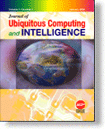|




    
|
|
Journal
of Ubiquitous Computing and Intelligence (JUCI)
American
Scientific Publishers (ASP)
| |
|

|
EDITORS-IN-CHIEF
Laurence T. Yang,
St. Francis Xavier University, Canada
Jianhua Ma,
Hosei University, Japan |
|
| |
|
|
|
 |
|
| INTRODUCTION |
The
any place/any time/any means vision of ubiquitous computing has
explosive impact on academics, industry, government and daily life.
This emergence is the natural result of research and technological
advances in wireless and sensor networks, embedded systems, mobile
computing, distributed computing, agent technologies, autonomic
computing and communication. Many novel but more specific computing
mechanisms and paradigms have been recently driven from the broad
view of ubiquitous computing, such as pervasive, context-aware,
sentient, invisible, disappearing, everyday, wearable, proactive,
autonomic, organic, sustainable, handheld, palpable, amorphous,
spray, embedded computing, ambient intelligence, etc.
Following
ubiquitous computers and networks, is a road towards ubiquitous
intelligence, i.e., computational intelligence pervasion in both the
physical world and the cyber world. Such right place/right
time/right means vision of ubiquitous intelligence will greatly
reform our world to create a smart world filled with a variety of
embedded intelligence or smart real and virtual things ranging from
software to hardware, from man-made artifacts to natural objects,
from everyday appliances to sophisticated systems, from small rooms
to large buildings, from enclosed sites to open spaces, from
stationary places to moveable vehicles, etc. The computational
intelligence will not only function as the methods or tools in
systems but also result in ubiquitous existence residing in everyday
objects, surrounding environments, diverse systems and even
ourselves. Such future existence of ubiquitous intelligence calls
for re-thinking of the conventional intelligent computing,
identifying implications and important issues of the foreseen smart
world, and finding corresponding solutions by joint efforts and
fusions of multiple disciplines. The ubiquitous intelligence, as an
emerging and very promising multidiscipline, aims at new models and
technologies for graceful integrations and mutual actions of real
worlds and virtual e-worlds with different scales and purposes.
JUCI
addresses the most innovative researches and developments in this
multidiscipline and includes all aspects related to ubiquitous
computing and ubiquitous intelligence as well as the smart world,
with emphasis on methodologies, models, semantics, awareness,
architectures, middleware, tools, designs, implementations,
experiments, evaluations, and non-technical but crucial factors in
the practical applications of ubiquitous computing and intelligence
related to economics, society, culture, ethics and so on. |
OBJECTIVES |
|
The objective of the
JUCI journal is to provide an outstanding channel for academics,
industrial professionals, educators and policy makers working in
the different disciplines to contribute and to disseminate
innovative and important new work in the broad ubiquitous
computing areas and the emerging ubiquitous intelligence field.
|
READERSHIP |
|
Scientists, engineers, researchers,
educators, graduate students, managers, and industrial
professionals. |
CONTENTS |
|
JUCI is a refereed international
journal, initially published quarterly, providing an international
forum to report, discuss and exchange experimental or theoretical
results, novel designs, work-in-progress, experience, case
studies, and trend-setting ideas. Papers should be of a quality
that represents the state-of-the-art and the latest advances in
methodologies, models, semantics, awareness, architectures,
middleware, tools, designs, implementations, experiments,
evaluations, applications, non-technical factors and stimulating
future trends. |
SUBJECT
COVERAGE |
|
The JUCI journal covers all research
and application aspects of the ubiquitous computing and ubiquitous
intelligence. Topics of interest include, but are not limited to: |
| 1. |
Embedded Hardware and
Systems |
|
Embedded
hardware support, system-on-a-chip (SOC), embedded system
architecture, hardware/software co-design, real-time systems,
power and energy-aware designs, testing and verification,
sensor networks, application-specific processors, wearable
computers/devices, etc. |
| 2. |
Ubiquitous Networking and
Intelligent Services: |
|
Ubiquitous wired
and wireless networks, intelligent network, ad hoc networking,
intelligent sensor network, ubiquitous/pervasive platform and
middleware, automated and adapted service, situated service,
open service architecture, intelligent web service,
intelligence service grid, etc. |
| 3. |
Ubiquitous Interaction and
Intelligent Management: |
|
Natural and
palpable interfaces to invisible computers, spontaneous and
continuous interaction, user intention/demand anticipation and
proactive computing, self-management system and autonomic
computing, organic computing, sustainable computing,
intelligence scalability, etc. |
| 4. |
Embedded Software and
Intelligence: |
|
Embedded related
operating system, compiler, assembler, middleware, software
architecture and design, memory management, scheduling,
embedded agent, embedded learning/reasoning program, embedded
communication and networking, etc. |
| 5. |
Smart Objects and
Environments: |
|
Smart
artifact/appliance/material, smart label and card, smart
textile and cloth, smart furniture, smart home and office,
smart laboratory and factory, smart classroom and school,
smart hospital and health care, aware room and building, smart
road and vehicle, intelligent environment, smart hyperspace,
smart platform and middleware, novel smart applications, etc. |
| 6. |
Context-aware Computing: |
|
Context
acquisition and representation, context media processing,
context database, context management, context framework and
middleware, context analysis and utilization, location-aware
application, power-aware system, resource-aware computation,
self-aware computers and systems, etc. |
| 7. |
Real and Cyber World
Semantics: |
|
Real world
models and semantic representations, real world reasoning,
user activity recognition and prediction, relations between
real and cyber spaces, cyber world ontology and axiom,
web/cyber semantics, web intelligence, etc. |
| 8. |
Ubiquitous Intelligence
Modeling: |
|
Distributed
artificial intelligence (DAI), distributed soft computing,
natural/biological modeling for ubiquitous intelligence,
multi-agent modeling approach, massive multi-agent system,
heterogeneous intelligence management and collaborations,
intelligence competition and evolution, amorphous computing,
spray computing, etc. |
| 9. |
Ubiquitous Privacy and
Trust: |
|
Privacy issues
in ubiquitous society, privacy regulation and low, privacy
intrusion automatic detection, privacy protection framework
and infrastructure, identity and behavior trust, trust model
and measure, risk estimation, trust management, security
technology for privacy and trust guarantee, etc. |
| 10. |
Ubiquitous Intelligence
Implications and Social Factors: |
|
Meaning and
impact of ubiquitous intelligence, social implications of
ubiquitous intelligence and smart world, positive and negative
sides of ubiquitous computing, ethical issues, training,
policy and legal issues, economic and culture impacts,
psychological and emotional factors, politeness in
computational intelligence, etc. |
|
|
|
